Runtao Liu
Pointing to a Llama and Call it a Camel: On the Sycophancy of Multimodal Large Language Models
Sep 19, 2025



Abstract:Multimodal large language models (MLLMs) have demonstrated extraordinary capabilities in conducting conversations based on image inputs. However, we observe that MLLMs exhibit a pronounced form of visual sycophantic behavior. While similar behavior has also been noted in text-based large language models (LLMs), it becomes significantly more prominent when MLLMs process image inputs. We refer to this phenomenon as the "sycophantic modality gap." To better understand this issue, we further analyze the factors that contribute to the exacerbation of this gap. To mitigate the visual sycophantic behavior, we first experiment with naive supervised fine-tuning to help the MLLM resist misleading instructions from the user. However, we find that this approach also makes the MLLM overly resistant to corrective instructions (i.e., stubborn even if it is wrong). To alleviate this trade-off, we propose Sycophantic Reflective Tuning (SRT), which enables the MLLM to engage in reflective reasoning, allowing it to determine whether a user's instruction is misleading or corrective before drawing a conclusion. After applying SRT, we observe a significant reduction in sycophantic behavior toward misleading instructions, without resulting in excessive stubbornness when receiving corrective instructions.
Follow-Your-Instruction: A Comprehensive MLLM Agent for World Data Synthesis
Aug 07, 2025Abstract:With the growing demands of AI-generated content (AIGC), the need for high-quality, diverse, and scalable data has become increasingly crucial. However, collecting large-scale real-world data remains costly and time-consuming, hindering the development of downstream applications. While some works attempt to collect task-specific data via a rendering process, most approaches still rely on manual scene construction, limiting their scalability and accuracy. To address these challenges, we propose Follow-Your-Instruction, a Multimodal Large Language Model (MLLM)-driven framework for automatically synthesizing high-quality 2D, 3D, and 4D data. Our \textbf{Follow-Your-Instruction} first collects assets and their associated descriptions through multimodal inputs using the MLLM-Collector. Then it constructs 3D layouts, and leverages Vision-Language Models (VLMs) for semantic refinement through multi-view scenes with the MLLM-Generator and MLLM-Optimizer, respectively. Finally, it uses MLLM-Planner to generate temporally coherent future frames. We evaluate the quality of the generated data through comprehensive experiments on the 2D, 3D, and 4D generative tasks. The results show that our synthetic data significantly boosts the performance of existing baseline models, demonstrating Follow-Your-Instruction's potential as a scalable and effective data engine for generative intelligence.
ModelGrow: Continual Text-to-Video Pre-training with Model Expansion and Language Understanding Enhancement
Dec 25, 2024Abstract:Text-to-video (T2V) generation has gained significant attention recently. However, the costs of training a T2V model from scratch remain persistently high, and there is considerable room for improving the generation performance, especially under limited computation resources. This work explores the continual general pre-training of text-to-video models, enabling the model to "grow" its abilities based on a pre-trained foundation, analogous to how humans acquire new knowledge based on past experiences. There is a lack of extensive study of the continual pre-training techniques in T2V generation. In this work, we take the initial step toward exploring this task systematically and propose ModelGrow. Specifically, we break this task into two key aspects: increasing model capacity and improving semantic understanding. For model capacity, we introduce several novel techniques to expand the model size, enabling it to store new knowledge and improve generation performance. For semantic understanding, we propose a method that leverages large language models as advanced text encoders, integrating them into T2V models to enhance language comprehension and guide generation results according to detailed prompts. This approach enables the model to achieve better semantic alignment, particularly in response to complex user prompts. Extensive experiments demonstrate the effectiveness of our method across various metrics. The source code and the model of ModelGrow will be publicly available.
VideoDPO: Omni-Preference Alignment for Video Diffusion Generation
Dec 18, 2024



Abstract:Recent progress in generative diffusion models has greatly advanced text-to-video generation. While text-to-video models trained on large-scale, diverse datasets can produce varied outputs, these generations often deviate from user preferences, highlighting the need for preference alignment on pre-trained models. Although Direct Preference Optimization (DPO) has demonstrated significant improvements in language and image generation, we pioneer its adaptation to video diffusion models and propose a VideoDPO pipeline by making several key adjustments. Unlike previous image alignment methods that focus solely on either (i) visual quality or (ii) semantic alignment between text and videos, we comprehensively consider both dimensions and construct a preference score accordingly, which we term the OmniScore. We design a pipeline to automatically collect preference pair data based on the proposed OmniScore and discover that re-weighting these pairs based on the score significantly impacts overall preference alignment. Our experiments demonstrate substantial improvements in both visual quality and semantic alignment, ensuring that no preference aspect is neglected. Code and data will be shared at https://videodpo.github.io/.
SafetyDPO: Scalable Safety Alignment for Text-to-Image Generation
Dec 13, 2024



Abstract:Text-to-image (T2I) models have become widespread, but their limited safety guardrails expose end users to harmful content and potentially allow for model misuse. Current safety measures are typically limited to text-based filtering or concept removal strategies, able to remove just a few concepts from the model's generative capabilities. In this work, we introduce SafetyDPO, a method for safety alignment of T2I models through Direct Preference Optimization (DPO). We enable the application of DPO for safety purposes in T2I models by synthetically generating a dataset of harmful and safe image-text pairs, which we call CoProV2. Using a custom DPO strategy and this dataset, we train safety experts, in the form of low-rank adaptation (LoRA) matrices, able to guide the generation process away from specific safety-related concepts. Then, we merge the experts into a single LoRA using a novel merging strategy for optimal scaling performance. This expert-based approach enables scalability, allowing us to remove 7 times more harmful concepts from T2I models compared to baselines. SafetyDPO consistently outperforms the state-of-the-art on many benchmarks and establishes new practices for safety alignment in T2I networks. Code and data will be shared at https://safetydpo.github.io/.
UTMath: Math Evaluation with Unit Test via Reasoning-to-Coding Thoughts
Nov 11, 2024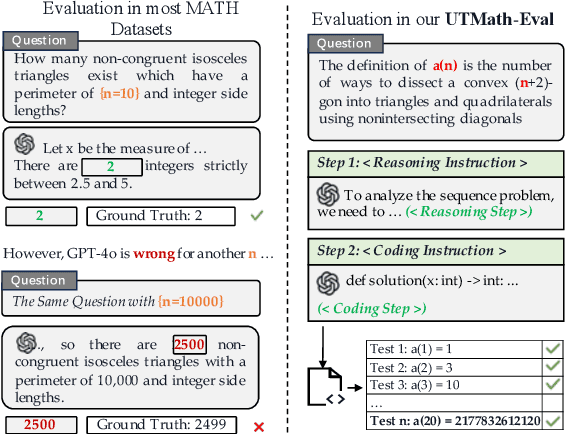
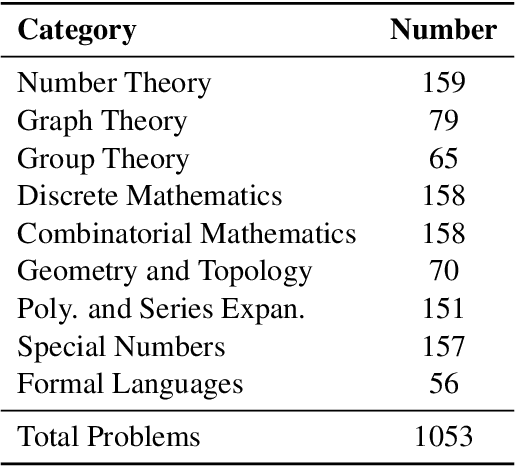
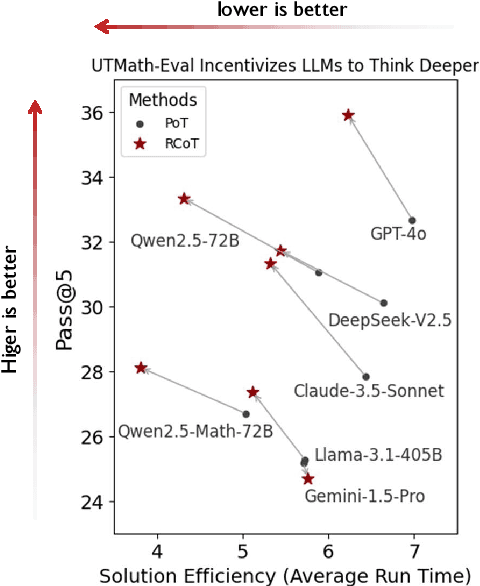
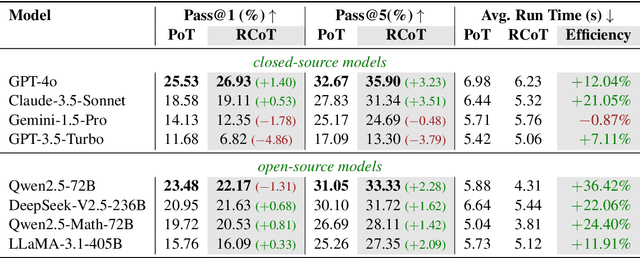
Abstract:The evaluation of mathematical reasoning capabilities is essential for advancing Artificial General Intelligence (AGI). While Large Language Models (LLMs) have shown impressive performance in solving mathematical problems, existing benchmarks such as GSM8K and MATH present limitations, including narrow problem definitions with specific numbers and reliance on predetermined rules that hinder accurate assessments of reasoning and adaptability. This paper introduces the UTMath Benchmark, which robustly evaluates the models through extensive unit tests. It consists of 1,053 problems across 9 mathematical domains, with over 68 test cases per problem. We propose an innovative evaluation framework inspired by unit testing in software development, focusing on both accuracy and reliability of results. Furthermore, we introduce the Reasoning-to-Coding of Thoughts (RCoT) approach, which encourages LLMs to perform explicit reasoning before generating code, leading to generating more advanced solution and improved performance. Furthermore, we are releasing not only the UTMath benchmark but also the UTMath-Train training dataset (more than 70k samples), to support the community in further exploring mathematical reasoning.
Bridge-Coder: Unlocking LLMs' Potential to Overcome Language Gaps in Low-Resource Code
Oct 24, 2024
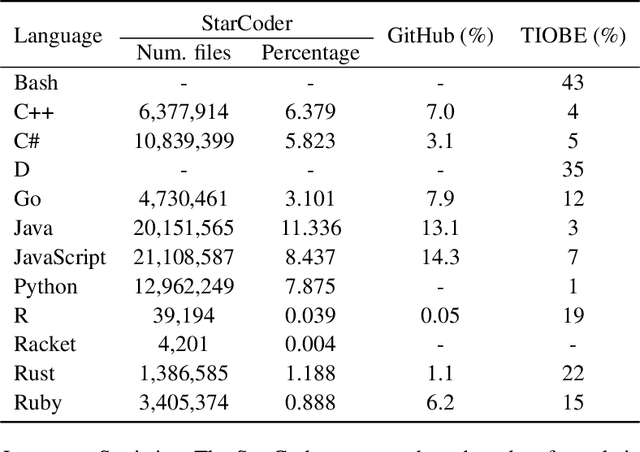

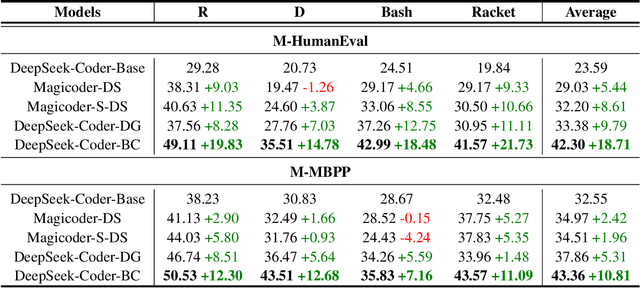
Abstract:Large Language Models (LLMs) demonstrate strong proficiency in generating code for high-resource programming languages (HRPLs) like Python but struggle significantly with low-resource programming languages (LRPLs) such as Racket or D. This performance gap deepens the digital divide, preventing developers using LRPLs from benefiting equally from LLM advancements and reinforcing disparities in innovation within underrepresented programming communities. While generating additional training data for LRPLs is promising, it faces two key challenges: manual annotation is labor-intensive and costly, and LLM-generated LRPL code is often of subpar quality. The underlying cause of this issue is the gap between natural language to programming language gap (NL-PL Gap), which is especially pronounced in LRPLs due to limited aligned data. In this work, we introduce a novel approach called Bridge-Coder, which leverages LLMs' intrinsic capabilities to enhance the performance on LRPLs. Our method consists of two key stages. Bridge Generation, where we create high-quality dataset by utilizing LLMs' general knowledge understanding, proficiency in HRPLs, and in-context learning abilities. Then, we apply the Bridged Alignment, which progressively improves the alignment between NL instructions and LRPLs. Experimental results across multiple LRPLs show that Bridge-Coder significantly enhances model performance, demonstrating the effectiveness and generalization of our approach. Furthermore, we offer a detailed analysis of the key components of our method, providing valuable insights for future work aimed at addressing the challenges associated with LRPLs.
LLMs Meet Multimodal Generation and Editing: A Survey
May 29, 2024
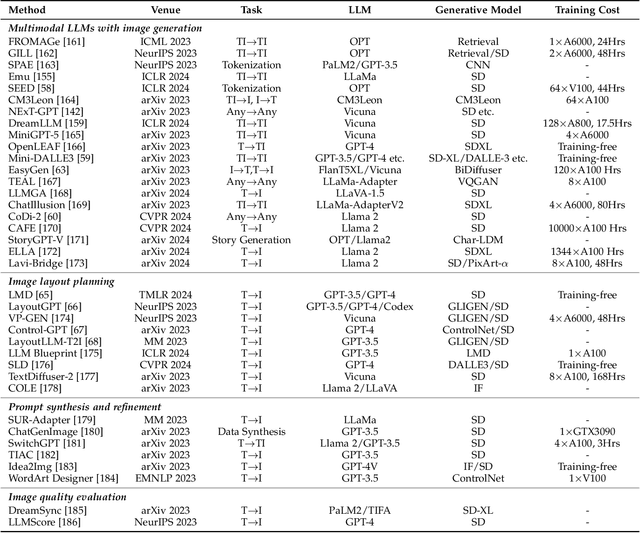
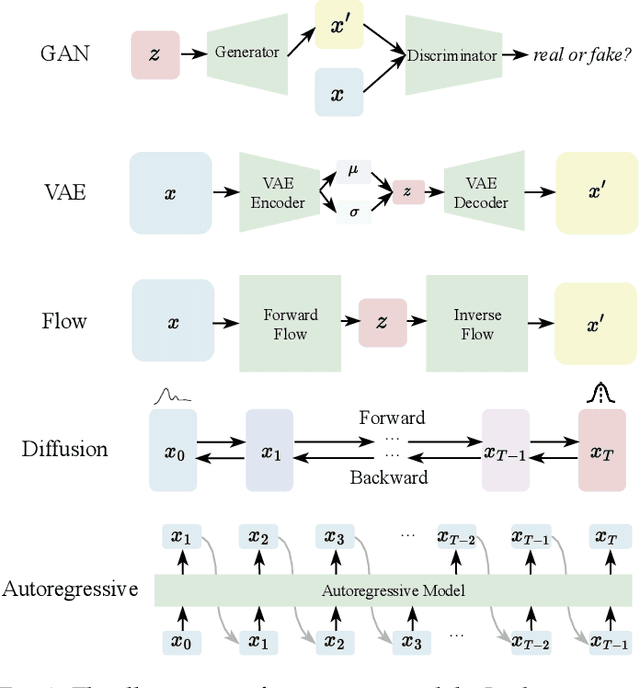
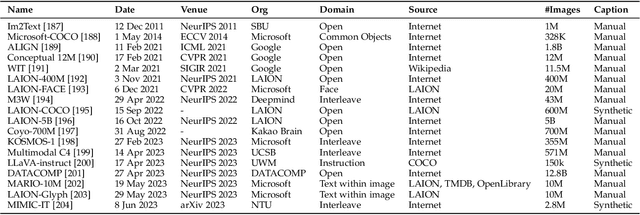
Abstract:With the recent advancement in large language models (LLMs), there is a growing interest in combining LLMs with multimodal learning. Previous surveys of multimodal large language models (MLLMs) mainly focus on understanding. This survey elaborates on multimodal generation across different domains, including image, video, 3D, and audio, where we highlight the notable advancements with milestone works in these fields. Specifically, we exhaustively investigate the key technical components behind methods and multimodal datasets utilized in these studies. Moreover, we dig into tool-augmented multimodal agents that can use existing generative models for human-computer interaction. Lastly, we also comprehensively discuss the advancement in AI safety and investigate emerging applications as well as future prospects. Our work provides a systematic and insightful overview of multimodal generation, which is expected to advance the development of Artificial Intelligence for Generative Content (AIGC) and world models. A curated list of all related papers can be found at https://github.com/YingqingHe/Awesome-LLMs-meet-Multimodal-Generation
Latent Guard: a Safety Framework for Text-to-image Generation
Apr 11, 2024Abstract:With the ability to generate high-quality images, text-to-image (T2I) models can be exploited for creating inappropriate content. To prevent misuse, existing safety measures are either based on text blacklists, which can be easily circumvented, or harmful content classification, requiring large datasets for training and offering low flexibility. Hence, we propose Latent Guard, a framework designed to improve safety measures in text-to-image generation. Inspired by blacklist-based approaches, Latent Guard learns a latent space on top of the T2I model's text encoder, where it is possible to check the presence of harmful concepts in the input text embeddings. Our proposed framework is composed of a data generation pipeline specific to the task using large language models, ad-hoc architectural components, and a contrastive learning strategy to benefit from the generated data. The effectiveness of our method is verified on three datasets and against four baselines. Code and data will be shared at https://github.com/rt219/LatentGuard.
Strengthening Multimodal Large Language Model with Bootstrapped Preference Optimization
Mar 13, 2024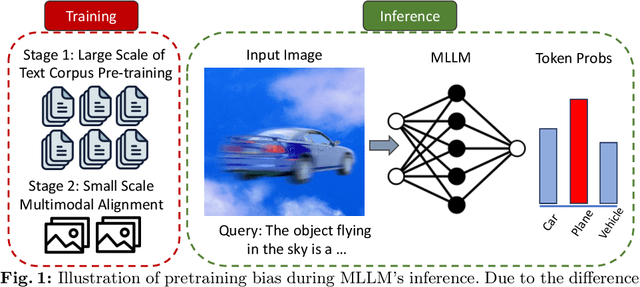
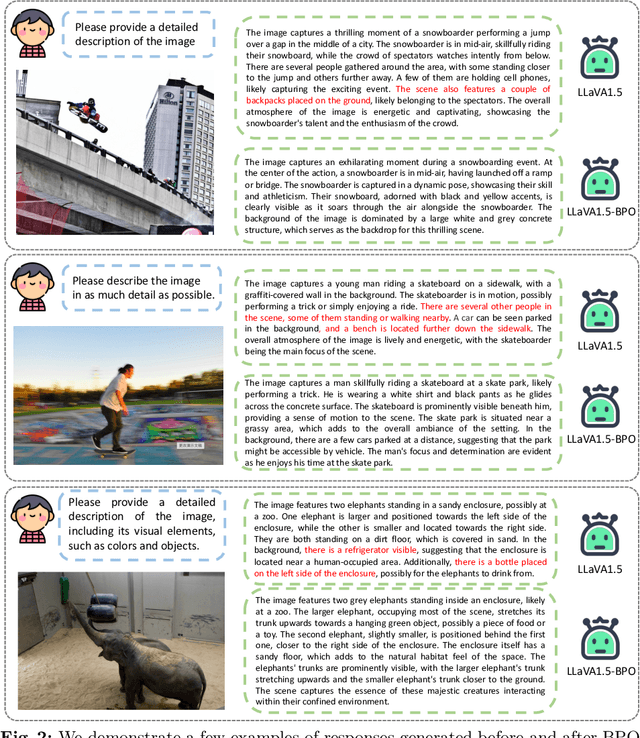

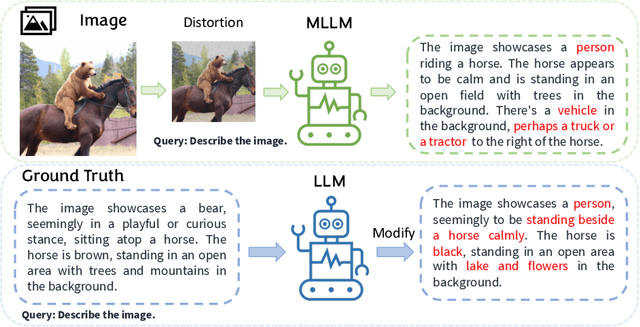
Abstract:Multimodal Large Language Models (MLLMs) excel in generating responses based on visual inputs. However, they often suffer from a bias towards generating responses similar to their pretraining corpus, overshadowing the importance of visual information. We treat this bias as a "preference" for pretraining statistics, which hinders the model's grounding in visual input. To mitigate this issue, we propose Bootstrapped Preference Optimization (BPO), which conducts preference learning with datasets containing negative responses bootstrapped from the model itself. Specifically, we propose the following two strategies: 1) using distorted image inputs to the MLLM for eliciting responses that contain signified pretraining bias; 2) leveraging text-based LLM to explicitly inject erroneous but common elements into the original response. Those undesirable responses are paired with original annotated responses from the datasets to construct the preference dataset, which is subsequently utilized to perform preference learning. Our approach effectively suppresses pretrained LLM bias, enabling enhanced grounding in visual inputs. Extensive experimentation demonstrates significant performance improvements across multiple benchmarks, advancing the state-of-the-art in multimodal conversational systems.
 Add to Chrome
Add to Chrome Add to Firefox
Add to Firefox Add to Edge
Add to Edge